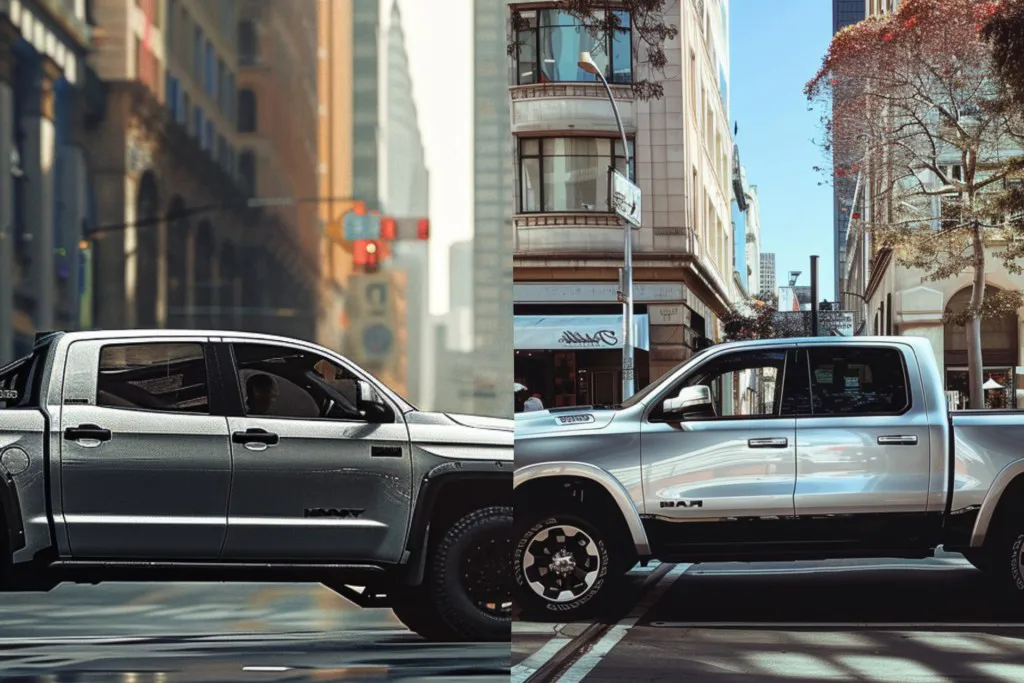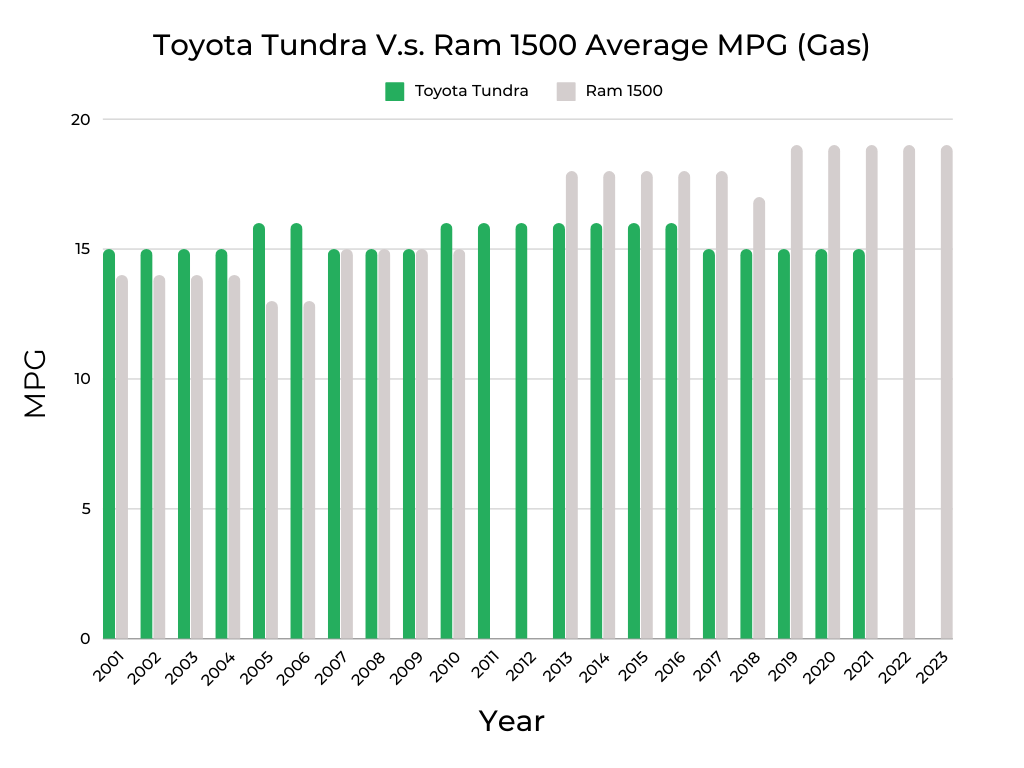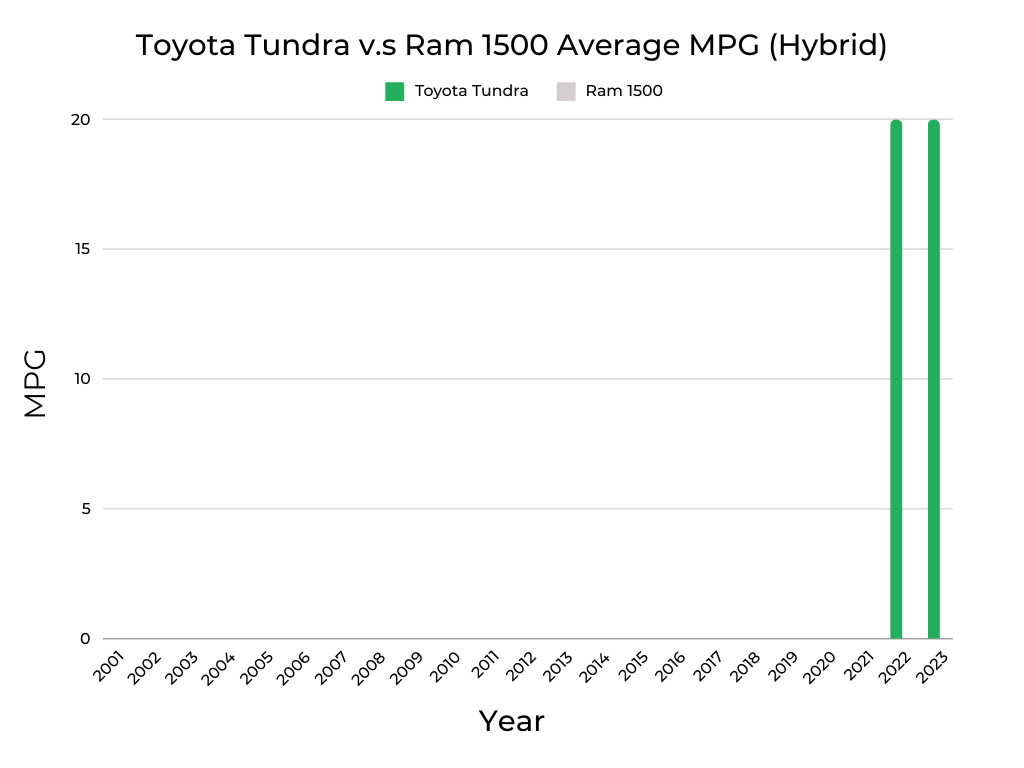| Income Bracket | Monthly Financing Cost Range | Cash Purchase Price Range | Toyota Tundra Years | Ram 1500 Years | Best Model Year: | Why? |
| < $5k | $42-$83 | $1,500-$3,000 | N/A | N/A | N/A | Neither truck offers used models at this price |
| $5k-$10k | $83-$125 | $3,000-$4,500 | 2003 | N/A | 2003 Toyota Tundra | Only “best of” option at this price point |
| $10k-$15k | $125-$187 | $4,500-$6,750 | 2008 | 2008, 2010 | 2010 Ram 1500 | Best FIXD Reliability Score |
| $15k-$25k | $187-$312 | $6,750-$11,250 | 2011, 2012, 2013 | 2011 | 2012 Toyota Tundra | More reliable, better safety rating |
| $25k-$35k | $312-$437 | $11,250-$15,750 | 2014, 2016 | 2014, 2015, 2016, 2017 | 2017 Ram 1500 | Perfect reliability score |
| $35k-$50k | $437-$625 | $15,750-$22,500 | N/A | 2018, 2019, 2020 | 2020 Ram 1500 | No “best of” Tundras in this price bracket |
| $50k-$74k | $625-$925 | $22,500-$33,300 | 2018, 2020 | 2021 | 2021 Ram 1500 | Identical reliability, better fuel economy from Ram |
| $75k-$99k | $925-$1,238 | $33,300-$44,550 | 2019, 2021 | N/A | 2019 Toyota Tundra | Most reliable option |
See the methodology for the table above.
Although the Ram 1500, Ford F-150, and Chevy Silverado have been the full-size pickup truck standard bearers seemingly forever, the Nissan Titan and Toyota Tundra joined the fold more than 20 years ago to give consumers more options.
All of these trucks have their charms, but today we’ll be comparing the Toyota Tundra and Ram 1500. Specifically, we’ll be looking at the 2001 through 2021 model years to find out which used models are the best bet for anyone in the market.
Toyota unveiled its latest generation Tundra in 2022, but the most recent generational change before that was way back in 2007. So even though the Tundra comes with the reputation for resale value and reliability enjoyed by nearly every Toyota vehicle, most used models over the past 15 or so years are also known for being outdated.
Over at Ram, the 1500 has been on sale since the 1980s with recent generational updates in 2002, 2009, and 2019. Though it typically plays second fiddle to the F-150 and Silverado when it comes to sales, the Ram generally outsells the Tundra by a large margin and is lauded for its ride comfort thanks to a coil-sprung rear suspension since 2013.
To determine which one of these trucks is the best bet, we’ve started by consulting our best and worst model year rankings for the Tundra and Ram. These articles are full of data including the objective and subjective reliability scores that are a primary focus of the rankings.
We also consider National Highway Traffic Safety Administration (NHTSA) safety scores, current market values according to Kelley Blue Book (KBB), fuel economy figures published on FuelEconomy.gov, and annual maintenance bills according to owners.
Of course, budget is always a priority when it comes to buying a vehicle, which is where the above table comes in. In it, you’ll find rows broken out by income range, financing costs, and average purchase price to help zero in on model years that fit your needs.
The model years listed have already been rated “best of” according to the respective rankings and then an overall choice is made for each price range with a quick explanation of the reasoning. The detailed explanation is covered below.
Another good tool in this journey is our used car buying checklist which provides helpful tips and education. For those interested in the competition, be sure to check out our best and worst model year rankings for the Ford F-150, Chevy Silverado, and Nissan Titan.
Price History Comparison | Toyota Tundra vs. Ram 1500
Average Market Value – Based on Owners’ Self-Reported Mileages | Toyota Tundra vs. Ram 1500
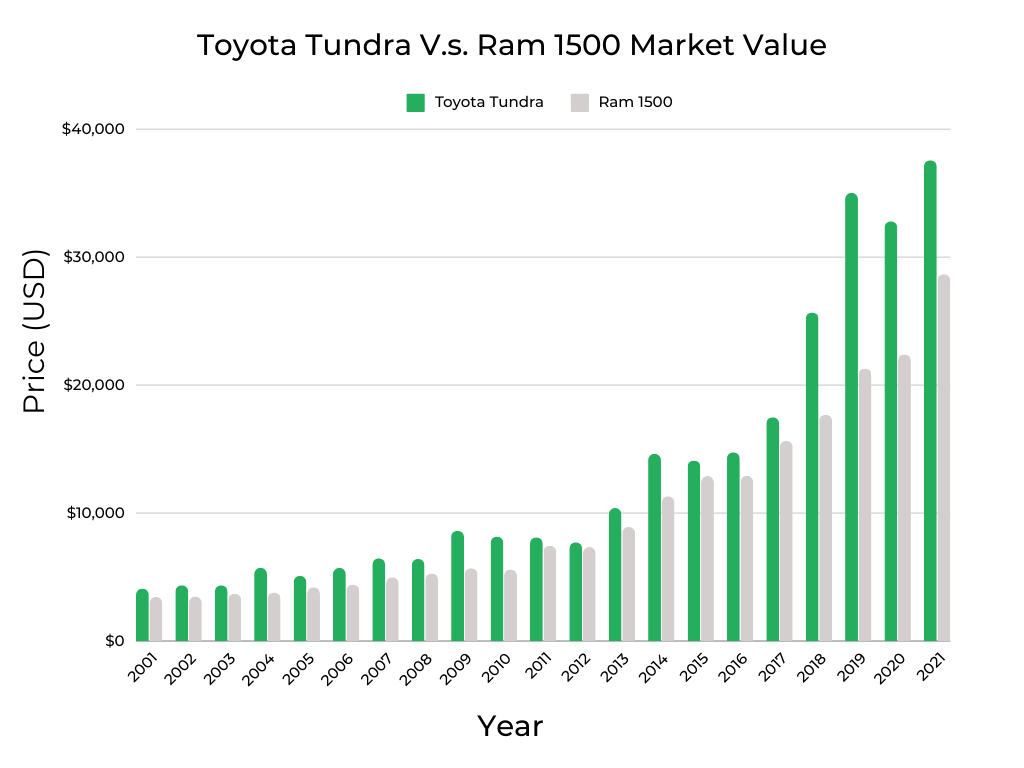
Looking over the chart above of market values for the Toyota Tundra (green bars) and Ram 1500 (gray bars), it’s clear that the Tundra enjoys a healthy resale advantage. It’s certainly part of Toyota’s reputation and in this case, the Tundra has a higher price tag than the Ram every single year between 2001 and 2021.
A common refrain used to explain this disparity is that Toyota is inherently more reliable. However, as we’ll look at below, that is not always the case. Sometimes it’s simply reality mirroring perception and for those shopping through an objective lens, is worth bearing in mind. Why pay more for a comparable truck if it’s not more reliable?
In any case, the point of this graph is to give you an idea of how far your budget will go based on the Tundra and Ram 1500 model years. Something to be aware of in that pursuit is that odometer readings can play a role in pricing. For example, the 2019 Tundra is significantly more expensive than the 2019 Ram but also averages 35,000 fewer miles on the clock.
Depreciation vs Maintenance Expenses
Another factor that often helps explain why one vehicle is more expensive than another is depreciation, which is responsible for driving down residual values over time. Most vehicles lose 10 to 15% of their value after 1 year of ownership and up to 50% after 5 years due to depreciation.
Given the overall higher values of the Toyota Tundra, you might expect the Ram 1500 to depreciate faster. However, that is not the case. We do not have a Ram 1500 chart to complement the above Tundra depreciation curve, but according to CarEdge.com, the Ram 1500 hits the 75% residual value mark with the 2019 model year.
The Tundra gets there faster with the 2020 model year and by the 2017 model year, a Tundra has only about 50% of its residual value. But the Ram 1500 didn’t hit this 50% milestone until 2015. In other words, the Ram depreciates more slowly than the Tundra but costs less on the open market.
Why is that relevant? Because a savvy buyer can potentially pay less for a Ram 1500 that holds its value better than a comparable Toyota Tundra if they know where to look. For the Ram, that involves looking for a model year that has already come down in price thanks to depreciation and that is objectively reliable, which we’ll cover below.
If it’s a Tundra you’re after, however, start with model years highlighted by the black box above. This 2005-2008 “sweet spot” covers trucks that have already benefited from depreciation, while still offering affordable maintenance costs per mile to keep them on the road. In particular, the 2008 Tundra is both a “best of” pick and in the sweet spot above.
Reliability Comparison | Toyota Tundra vs. Ram 1500
As promised, here we have charts comparing the reliability of the Tundra and Ram 1500. The chart above on the left looks at objective reliability, which is calculated using data recorded by thousands of FIXD devices installed in owner trucks. As you can see, the Ram 1500 (gray bars) outperforms the Toyota Tundra on this metric consistently.
In fact, during 14 of 21 model years between 2001 and 2021, the Ram is objectively more reliable than the Tundra. So much for that perception that Toyota’s are automatically the most reliable option. Notable outliers to be aware of are the 2003 and 2010 model years.
In 2003, the Tundra was far more reliable than the Ram. That same year, the Toyota earned a “best of” nod on the model year rankings, and the Ram was rated “worst of”. The reverse was true in 2010 when the Ram far outstripped the Tundra for this metric.
Reinforcing the perception vs. reality discussion is the chart on the right that compares how reliable owners think their trucks are. Here, the rating is much closer. But considering this is a subjective metric, it illustrates the importance of relying on more than just family and friend opinions when it comes to buying a used Tundra or Ram.
Longevity Comparison | Toyota Tundra vs. Ram 1500
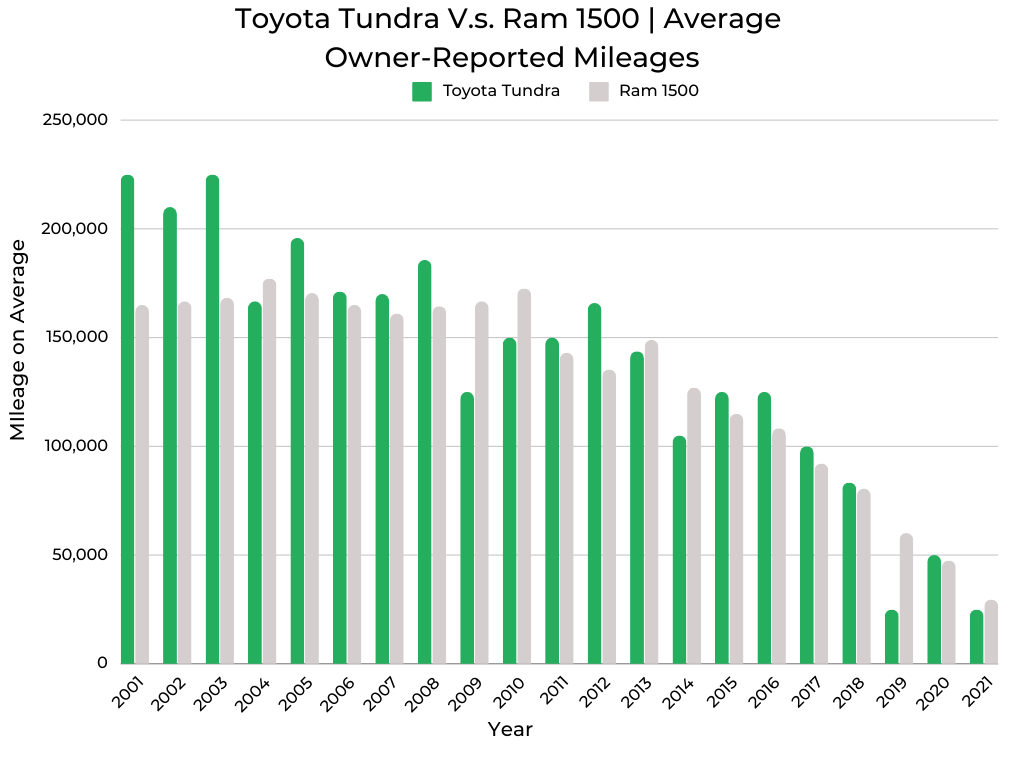
The purpose of the chart above, which shows average owner-reported odometer readings for these trucks, is to give you an idea of what kind of mileage to expect based on which model year Toyota Tundra or Ram 1500 you’re looking at.
Both trucks run up to the 150,000-mile mark with relative ease, but only the Tundra hits and crosses the 200,000-mile mark. Everyone has a different opinion on what is considered high mileage, but this should help you find a Ram 1500 or Toyota Tundra in your comfort zone.
We’ll look at this in more detail below, but the big mileage figures shown here are not too surprising considering 22% of both Tundra and Ram 1500 owners report primarily using their truck for lots of driving in the form of travel and long commutes.
Who Should Buy These Cars: The Legacy of The Toyota Tundra & Ram 1500
| Frequent Use Categories: | Toyota Tundra | How Useful? (Out of 5 Stars) |
Ram 1500 | How Useful? (Out of 5 Stars) |
| Family Vehicle | * * * | * * * |
| Lots of Driving (travel/long commute) | * * * | * * * |
| Hauling/Towing | * * * | * * * |
| Office on Wheels | * | * |
| Sport/Fast Driving | * | * |
| Luxurious Driving | * | * |
| Outdoor/Off-Road | * * * | * * |
Here is the table regarding the aforementioned note about how owners primarily use their Toyota Tundras and Ram 1500s. Lots of driving is generally considered an acceptable way to rack up miles as it results in less wear and tear than stop-and-go driving.
Both of these trucks register 3 stars for use as a family vehicle, which means a large percentage of owners buy these trucks with safety in mind. However, the 2- to 3-star scores for towing and off-roading are categories that would-be buyers need to be focused on.
Although the Tundra and Ram 1500 are designed and built to handle these tasks, both activities naturally incur a higher degree of wear and tear. So be sure to inquire with prior owners about the details of how much towing and off-roading was done and what they did from a preventative maintenance perspective to prolong the truck’s longevity.
Driver Experience | A Summary of The Top 10 Toyota Tundra vs. Ram 1500 Reddit Posts:
Another resource you can use to narrow down the best-used Toyota Tundra or Ram 1500 for your needs is the
What Car Should I Buy Reddit? An interesting foil to our data-driven best and worst model year rankings, this forum is a great place to gather unfiltered input on these trucks.
To help you avoid getting stuck down the rabbit hole too far, we’ve gone ahead and sifted through this Reddit to look for common themes on which truck to buy, the Toyota Tundra or the Ram 1500. Regardless of whether you’re looking at a more recent model year like 2018 or something older, say 2010, there are some clear agreements among Redditors.
For one, the Ram receives higher marks for its cabin and technology, which is unsurprising when you consider the Tundra remained part of a single generation between 2007 and 2021, a period that all but guarantees staleness setting in.
Also, there was a long stretch where both trucks offered a 5.7L V8 that made similar power, but the Toyota’s is often pointed to as being more reliable, which we know is not necessarily the case. For sure, the common opinion that the Tundra has higher resale values is accurate, but as a buyer of a used truck, that may not be a priority.
Year-by-Year Comparison | Toyota Tundra vs. Ram 1500
Best & Worst Years | Toyota Tundra vs. Ram 1500 | 2001-2024

I keep referencing the best and worst model year rankings of the Toyota Tundra and Ram 1500. These articles are full of useful insight, but also a lot of data. So, we’ve generated the above graphic to distill all that information into a simple, easy-to-reference format.
Any model years in the red are considered “worst of” and are best avoided. Those in the green have received a “best of” rating and any model years that fall within the yellow sections are those that we do not yet have enough data to make an accurate call.
Also, make note of blue-circled model years. This indicates the start of a new generation, an occasion often marked by poor reliability as the automaker works through new production problems. You can see that theme play out with the 2007 Tundra, 2002 Ram 1500, and 2009 Ram 1500.
If you were to overlay the Tundra’s depreciation sweet spot with this timeline, you would find that the 2008 model is both in that zone and a “best of” truck, making it a good place to start. Though we do not have this depreciation zone for the Ram 1500, the 2008, 2010, and 2011 model years are all “best of” options with relatively low market values.
Important Features Timeline | Toyota Tundra vs. Ram 1500
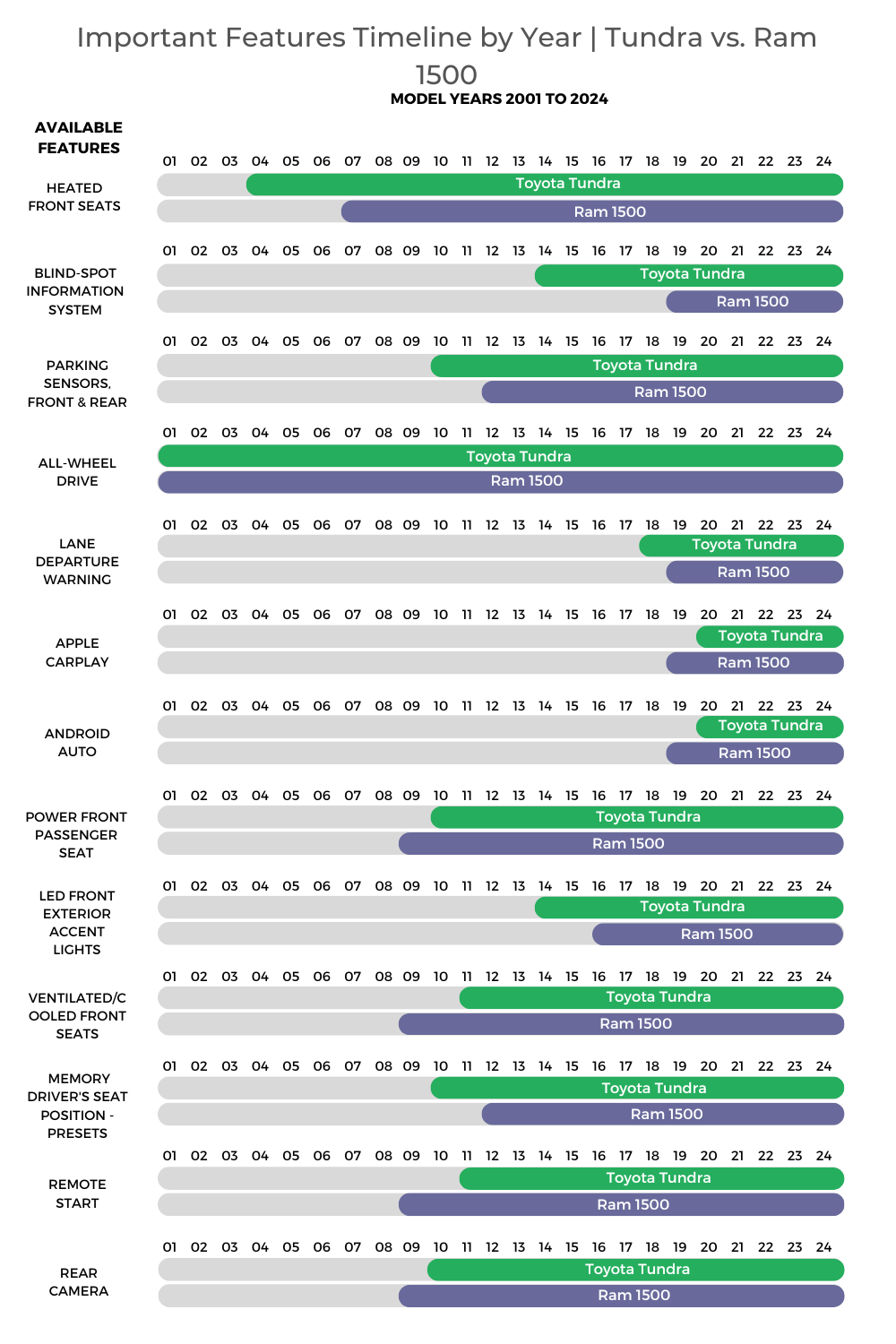
Along with understanding reliability and market values, you may want to know when popular amenities like heated front seats were first available in the Tundra and Ram 1500. That is what the timeline graphic above aims to address. For example, those heated seats have been offered on the Tundra since 2004 and the Ram since 2007.
Ventilated front seats didn’t show up until 2011 on the Tundra, but Ram started offering them on their 1500 as of 2009. As for modern tech like Apple CarPlay and Android Auto, you can only go back to a 2020 Toyota Tundra or 2019 Ram 1500 if it’s a must-have.
These days, advanced driver–assistance systems are increasingly ubiquitous, but Toyota has offered blind-spot monitoring on the Tundra for the past 10 years. It didn’t arrive on the Ram 1500 until 2019, the same year Ram started offering lane-departure warning.
Features not shown above include 4WD, which both trucks have offered since day one, and a hybrid powertrain, which only the Tundra offers and only as of 2022. But you could still get a manual transmission on a Ram 1500 as of 2009 versus the Tundra, which requires going back to 2006.
Maintenance Costs (Year-by-Year Average) | Toyota Tundra vs. Ram 1500
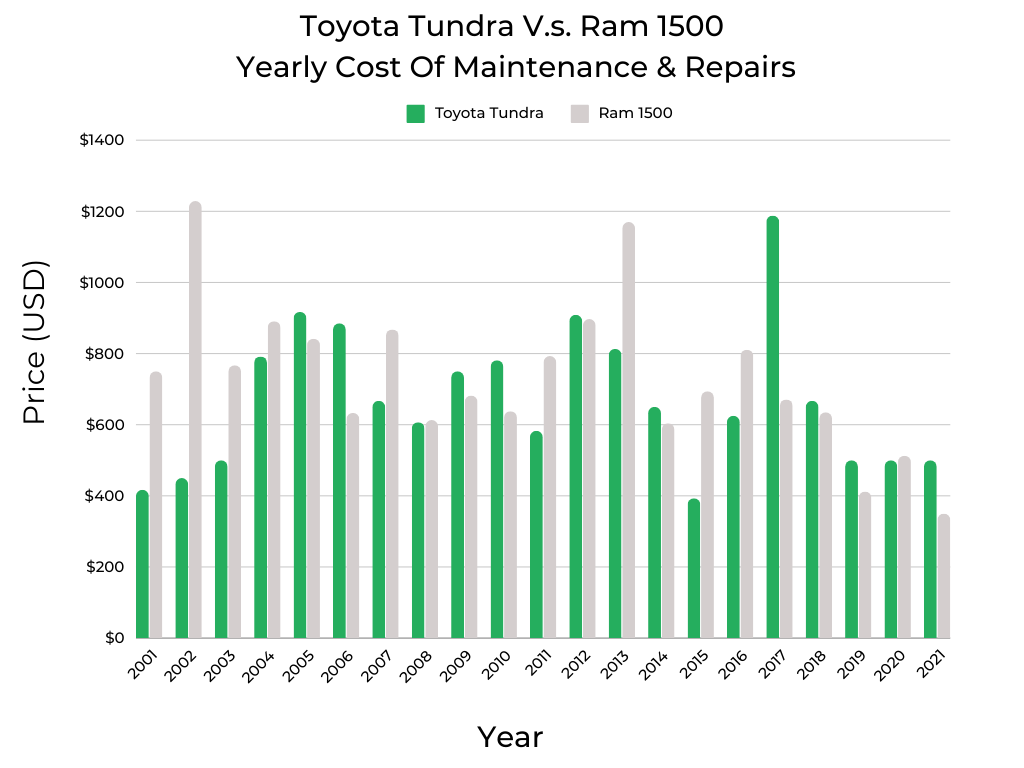
Understanding how much a vehicle costs to maintain on an annual basis is another important data point when shopping the used marketplace. According to owners, that figure averages $671 for the Toyota Tundra and $723 for the Ram 1500.
The chart above plots these figures each year to help visualize which trucks may cost you more. For example, 2017 is the only model year that the Tundra cracked the $1,000 mark. It also happens to be on the wrong side of the Tundra model year rankings, so is best avoided anyway.
The 2002 and 2013 Ram 1500 are also on that truck’s “worst of” model year rankings and post high annual maintenance costs as you can see on the chart above.
Keep in mind, however, that high service costs do not automatically mean a truck is unreliable. An owner who is meticulous about upkeep will rack up more regular visits to the shop than an owner who runs their vehicle into the ground. So be sure to do your homework with the previous owner before making a purchase.
Safety Rating Comparison | Toyota Tundra vs. Ram 1500
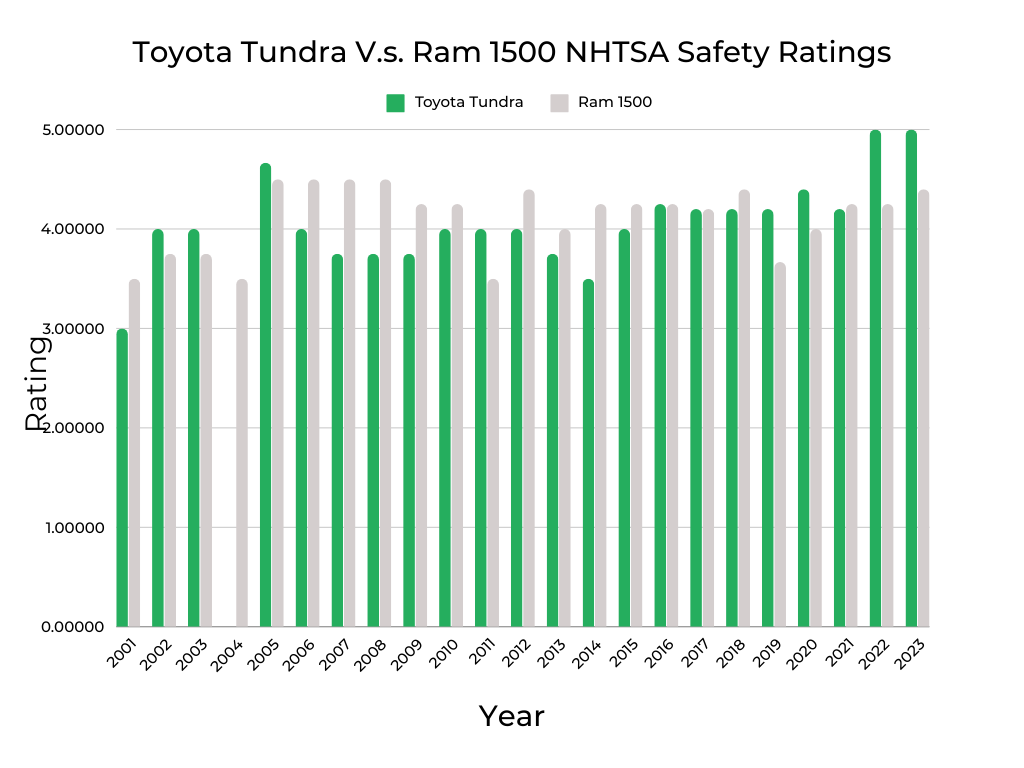
As mentioned earlier, both the Toyota Tundra and Ram 1500 see regular use as family vehicles. So, you would expect them to do well in NHTSA safety testing. The chart above compares these safety ratings and although the Ram fares better about half the time, for the most part, both pickups are around the 4 out of 5 star mark for this metric.
One year to watch for is the 2011 Ram 1500, which posted a relatively steep decline in safety scores versus 2010. It was likely driven by the NHTSA instituting stricter test protocols that year, an event that drove scores down across the industry. However, the Tundra appears to have been unaffected by this.
That being said, the 2001 through 2003 Tundra failed to crack the 4-star mark and the 2001 model fared particularly poorly. All 3 of these trucks are on the wrong side of the Tundra model year rankings though, so should be avoided anyway.
Fuel Efficiency Comparison | Toyota Tundra vs. Ram 1500
Last but not least in our comparison of used Toyota Tundras and Ram 1500s is fuel economy. Now, full-size pickup trucks are not exactly renowned for sipping fuel, but as you can see on the chart above, some do so better than others.
Between 2001 and 2010, it’s a fairly close matchup with both the Tundra and Ram hovering around 15 mpg on average. But the Ram pulls ahead by a bit in 2013 and by a lot in 2019, the latter of which coincides with the start of a new generation and its accompanying more efficient powertrains.
Only the Tundra has ever offered a hybrid powertrain, but as you can on the above right chart, that’s only been since 2022. And although the 20 mpg rating offered by these Tundras is a nice bump over what the 2019 Tundra could muster, the 2022 and 2023 Rams aren’t too far behind.
Of all the trucks we’ve looked at, in the Toyota corner, a 2008 Tundra looks like a good bet as it has a “best of” rating, sits in the depreciation sweet spot, and earns 15 mpg on average. The 2008 and 2010 Ram 1500s are also “best of” models, match the Tundra’s fuel economy figure, and undercut it on market value making them good options for Ram fans.
Methodology
- Compare two vehicles, the Toyota Tundra vs. Ram 1500, and provide a comprehensive analysis.
- Gather relevant information and data on both vehicles from reliable sources, such as manufacturer specifications, expert reviews, customer feedback, industry reports, and data sources like manufacturer websites, FIXD App, Kelley Blue Book, FuelEconomy.gov, and NHTSA.
- Collect data on various aspects, including performance, safety features, fuel efficiency, maintenance costs, reliability, owner satisfaction, and market value.
- Identify the key criteria that will be used to evaluate and compare the two vehicles.
- Ensure the criteria cover both objective factors (such as performance metrics, safety ratings, and fuel efficiency) and subjective factors (such as owner satisfaction, comfort, and features).
- Examine the safety features and ratings of both vehicles.
- Evaluate crash test ratings, advanced driver assistance systems (ADAS), active and passive safety features, and any notable recalls or known issues related to safety.
- Consider both NHTSA safety ratings and IIHS awards for a comprehensive safety assessment.
- Analyze the fuel economy of both vehicles based on EPA mileage estimates.
- Compare their MPG ratings, average full-tank range, and any significant differences in fuel efficiency.
- Assess the average annual maintenance and repair costs for both vehicles.
- Consider data from surveyed owners and other reliable sources, such as FIXD App owner surveys, to determine the overall cost of ownership over time.
- Evaluate the reliability of both vehicles based on owner reports, FIXD App data, and any known issues or recalls.
- Consider factors such as engine reliability, common problems by model year, long-term durability, and owner reliability scores gathered from surveys.
- Consider owner satisfaction by gathering information from forums, online communities (Reddit: r/whatcarshouldIbuy), customer reviews, and owner reliability scores.
- Summarize key factors that owners appreciate and any common complaints or drawbacks mentioned by owners.
- Compare the features and technologies offered by both vehicles.
- Highlight any notable differences in terms of infotainment systems, connectivity options, driver assistance features, interior quality, and available upgrades.
- Assess the market value and depreciation of both vehicles.
- Compare average prices, resale value, and how the vehicles hold their value over time.
- Consider average private-seller valuations from Kelley Blue Book (KBB) for a comprehensive assessment.
- Summarize the findings of the comparison, highlighting the positives and negatives of each vehicle.
- Provide a fair and balanced recommendation based on the comparison, considering factors such as budget, personal preferences, specific needs of the buyer, and the comprehensive analysis conducted.
Sources:
- KBB Values: Average private-seller valuations as supplied by Kelley Blue Book (KBB), based on a Toyota Tundra and Ram 1500 with typical mileage for that respective model year.
- Fuel Economy: Mileage-per-gallon estimates according to the EPA MPG on Fueleconomy.gov.
- Annual Maintenance/Repairs: Upkeep expenses as reported by surveyed Toyota Tundra and Ram 1500 owners.
- Safety Ratings: Crash test data collected and reported by NHTSA. We average all ratings for each year to come up with a simplified, average safety score. This makes it easier to look at on a graph. We also collected IIHS Awards for this article.
- Vehicle Features: Most or all information gathered on vehicle features were from the manufacturer websites, in this case RamTrucks.com and Toyota.com

Niel Stender grew up doing replacement work on his old Cherokee and sweet Mitsubishi Starion, which led to a degree in mechanical engineering and a job at Ford as a vehicle dynamics engineer. His writing infuses that automotive background with sales and marketing experience. Writing about cars for close to a decade now, he enjoys digging into some of the more technical mechanical systems under the hood and throughout a vehicle.

